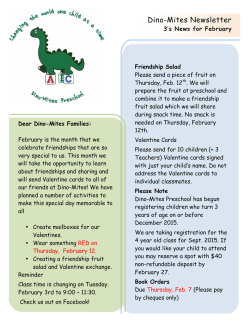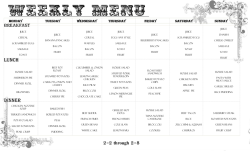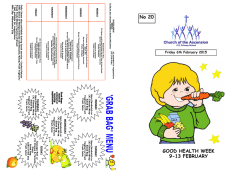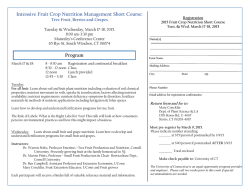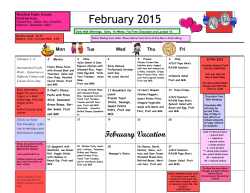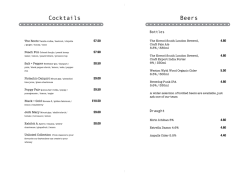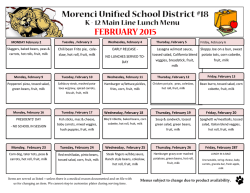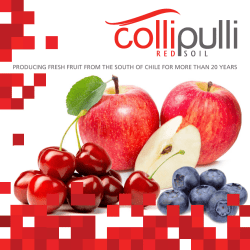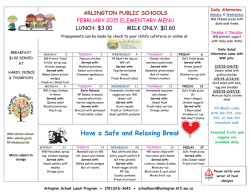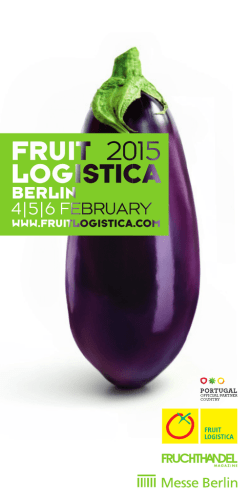
My Five Senses (Kindergarten) “Focus on Fruit.”
My Five Senses (Kindergarten) Write on the Chalkboard “Focus on Fruit.” Grow healthy and strong by eating fruit every day. NUTRITION OBJECTIVES CHECK LIST Students prepare food and taste a fruit salad. Students express ways they can eat more fruit every day. Students explain the health benefits of eating fruit. Students identify that apples, oranges, grapes and kiwi are fruit and they fit in the fruit group of MyPlate. MATERIALS AND INGREDIENTS Bins Teacher Provides Will be Delivered In Kitchen Bin - chef knife (teacher only) - cutting board (teacher only) - apple wedger - 4 medium bowls - large mixing bowl - mixing spoon - - In Paper Goods Bin - 8 plastic spoons - plastic knives* - small paper plates* - plastic forks* - napkins* - plastic gloves (2 per student) *one per student My Five Senses (K) Page 1 of 13 - activity sheet copies* recipe copies* large chart to collect sense information on the four fruits MyPlate poster book: "My Five Senses" by Aliki 4 apples 4 oranges bunch of grapes (1-2 lb.) 4 kiwi fruit plastic coated paper plates* SET-UP Copies: Make copies of Five Senses Fruit Salad recipe (each student) and activity sheet (each student) Note: Only make copies of second activity sheet if you think there will be time for students to complete. Work area: Students will work individually at their desks. Have nutrition table ready for lesson materials and ingredients. Food-prep: Wash apples, grapes, oranges and kiwis. Put grapes in a bowl. Cut apples into quarters for students to later cut into smaller pieces. Peel oranges and divide for students to later cut into smaller pieces. Cut the kiwi fruit in half. Eight students will spoon or scoop out the pulp of the kiwi and cut it up. Important: the students working with the kiwi will need to use plastic spoons and knives for scooping and cutting. Have plastic coated paper plates, plastic knives, and plastic gloves ready for students to use when cutting fruit. Have paper plates, plastic forks, and napkins ready for serving the salad. Other-prep: Create a My Five Senses Chart (see chart at end of lesson for example). Use chart paper, chalkboard, or use an overhead device to show the example chart. Display this chart where you can write on it easily, but also where the students can see it. Have the book, "My Five Senses" ready to read to the class. INTRODUCTION WITH STUDENTS • • • • • What are the five senses? (sight, hearing, smell, taste and touch) Refer to the Key Behavior on the board and tell students that you can use all five of your senses to “Focus on Fruit” and enjoy eating it every day and that eating fruit every day is very important for their health! Our five senses help us understand the world around us. Read book, "My Five Senses" by Aliki. While reading, engage the students in conversation about the senses they use while doing the activities mentioned. Ask the students what senses they are using while listening to the story. Tell students that today we are going to explore grapes with our five senses, and then we will make a delicious Five Senses Fruit Salad. PROCESS Step 1: Have students wash their hands with soap and warm water. Step 2: Pass out the activity sheet, napkins and one grape to each student. Ask students not to touch their grape. My Five Senses (K) Page 2 of 13 Step 3: Go over the activity sheet with students. Have them keep the grape on their napkin for looking at only. Ask students to describe what their grape looks like. Tell students to write what their grape looks like in the box next to the word "sight". Encourage them to use colors, shapes or comparisons to other objects. Write their answers on the class chart and continue to do so for each sense. Step 4: Point to the row below sight. Ask the students what the next sense is (touch). Model how they can use the tips of their fingers to feel the texture of their grape. Have them fill in the box for the sense “touch”. Write their answers on the class chart. Step 5: Now show the students how to complete the last 3 senses. Model how they will hold the piece of fruit under their nose to explore the smell of the grape. Then show them how to place the fruit carefully on their tongue to explore the taste of the grape. Finally model how they can bite into their grape, listening to the sound the fruit makes between their teeth. Step 6: After completing their 5 senses chart, and class chart, pass out the recipe, plates, knives and plastic gloves. Go over the recipe with the students. Pass out the fruit for the students to cut up. Important: Don’t forget the remaining grapes. Demonstrate to the 8 students working with the kiwi fruit how to scoop and cut. Step 7: When students have finished cutting, collect and add all the fruit together into one bowl as the students watch. Step 8: Hand out plates, forks and napkins to each student. Serve a spoonful of fruit salad to each student. Step 9: Let’s Eat, Let’s Talk. While students are eating ask them what they learned by having them explain how fruit helps our bodies. Encourage students to use their five senses to “Focus on Fruit” and enjoy eating it every day. Ask and discuss the questions in Make Health Happen. Step 10: If there is time pass out the Fruit Salad activity sheet and have students write words to describe the whole salad using their 5 senses or do one as a whole class. Have the students use the words on their 5 senses chart. The students can write their words upside down, sideways, etc. to make the words look like fruit in a salad or they can draw and color fruit pictures. Step 11: Have students take their recipes home to share with their families. My Five Senses (K) Page 3 of 13 What did your 5 senses like about the fruit salad? Why is it a healthy choice to take this recipe home and share it with your family? How often do you need to eat fruit? What fruit have you eaten today? What steps could you take to make the salad at home with your family? REINFORCING STANDARDS Comprehensive Health • GR.K-S.2-GLE.1 Identify the major food groups and the benefits of eating a variety of foods. Reading, Writing and Communicating • GR.K-S.1-GLE.1 Oral communication skills are built within a language-rich environment. • GR.K-S.1-GLE.2 Communication relies on effective verbal and nonverbal skills. • GR.K-S.2-GLE.2 A concept of print to read and a solid comprehension of informational texts are the building blocks for reading. • GR.K-S.2-GLE.3 Decoding words in print requires alphabet recognition and knowledge of letter sounds. • GR.K-S.3-GLE.1 Text types and purposes, labels, and familiar words are used to communicate information and ideas. • GR.K-S.3-GLE.2 Appropriate mechanics and conventions are used to create simple texts. My Five Senses (K) Page 4 of 13 BACKGROUND INFORMATION We rely on our five senses (sight, hearing, smell, taste and touch) to tell us about the world around us. The five sense organs (eyes, ears, nose, tongue and skin) send messages via nerves to the brain. Sight: Our eyes respond to light and send messages to the brain so that we can see the world around us. Scientists are still not sure exactly how the brain makes sense of the information from the eyes. Hearing: Sound waves are collected by the earflap and channeled into the ear canal. There, the eardrum converts the waves to vibrations, which are passed on by the tiny bones of the middle ear. The vibrations cause ripples in the liquid of the inner ear, which bend the tiny hairlike receptor cells deep inside the inner ear. As the hairs bend, they produce nerve impulses, which are sent to the brain. Smell: As you breathe in through your nose, the tiny hair-like structures called cilia are able to detect smells in the air. Smell is 20,000 times more sensitive than taste in humans, and the human nose can identify around 10,000 different smells. The sense of smell has a strong influence on the sense of taste. Food smells can elicit a strong association to happy family meals or holiday meals. Taste: Our tongues are covered with thousands of tiny bumps called papillae. On the sides of the papillae are taste buds. As we chew our food, small particles of it dissolve into the saliva and then come into contact with our taste buds. The taste buds send information about the food to the brain. The sense of taste and the sense of smell work together to give you the flavor of the food. Taste buds are more sensitive in young children than in adults. Touch: The skin that covers our bodies is divided into two layers. The thin outer epidermis is continually wearing away. Beneath the epidermis is the dermis where the skin's sense receptors are located. There are several types of sense receptors in the skin, and each one detects a different sensation. Usually several receptors are stimulated at the same time. People who are blind often develop a highly sensitive sense of touch. Although we primarily eat for nutritional reasons, it is also an enjoyable experience. Our five senses work together to allow us to enjoy our meals. Many people rush through their meals and forget to spend time relishing the information their five senses send to the brain about the food they are eating. Most children like fruit. Fruit is nutritious and delicious. It is a healthy addition to any meal as well as an excellent snack food or dessert due to its sweet taste and refreshing juiciness. Fruit supplies energy in the form of carbohydrates, plus vitamins, fiber, and some minerals. It is also low in calories due to the high water content and little or no fat content. The main contribution fruit makes to our diet is vitamins, especially vitamin C and beta-carotene. Certain fruits provide some minerals, for example: potassium in bananas, pears and oranges; iron in berries and dried fruits; and small amounts of calcium and magnesium. Fruit also contributes soluble and insoluble fiber. Since fruit is packed with nutrients, eating a variety of fruits helps ensure you are getting adequate amounts of vitamins, minerals and fiber. Research also shows a high intake of fruits and vegetables can help prevent diseases such as some cancers and heart disease. My Five Senses (K) Page 5 of 13 Five Senses Fruit Salad Ingredients: Yield: 10 servings 4 apples 4 kiwi fruit 4 oranges 1 bunch of grapes Directions: 1. 2. 3. 4. Wash, core and cut the apples into small pieces. Peel and cut the oranges into small pieces. Wash and cut the grapes in half. Cut the kiwi fruit in half, scoop out the green middle with a spoon and cut it into small pieces. 5. Put all the fruit into a bowl and mix it up. 6. Eat and enjoy! Focus on fruit! Use your five senses to enjoy eating fruit every day! This material was funded by USDA’s Supplemental Nutrition Assistance Program. The Supplemental Nutrition Assistance Program provides nutrition assistance to people with low income. It can help you buy nutritious foods for a better diet. To find out more, contact your county social services office. This institution is an equal opportunity provider and employer. . My Five Senses (K) Page 6 of 13 Ensalada de Frutas de Nuestros Cinco Sentidos Ingredientes: Porciones: 6-8 4 manzanas 4 kiwis 4 naranjas 1 racimo de uvas Instrucciones: 1. 2. 3. 4. Lavar y pelar la manzana, y cortarla en pequeños trocitos. Pelar la naranja y cortarla en trozos pequeños. Lavar y cortar las uvas en mitades. Cortar el kiwi por la mitad, sacar con una cuchara la parte verde del medio, y cortar en trocitos. 5. Colocar toda la fruta en un tazón y mezclar. 6. ¡A comer y disfrutar! ¡Concéntrate en las frutas! ¡Usen los cinco sentidos para disfrutar comiendo frutas todos los días! Este material se desarrolló con fondos proporcionados por el Supplemental Nutrition Assistance Program (SNAP en inglés) del Depatamento de Agricultura de los EE.UU. (USDA siglas en inglés). SNAP ofrece asistencia relacionada con la nutrición para gente con recursos limitados. Estos beneficios le pueden ayudar a comprar comida nutritiva para una mejor dieta. Para obtener más información, comuníquese con la oficina de servicios sociales de su condado. USDA es un proveedor y empleador que ofrece oportunidad igual para todos. My Five Senses (K) Page 7 of 13 Our Five Senses Name: ____________________ Date: __________ Fruit: Grape Sight What does your fruit look like? Touch What does your fruit feel like? Smell What does your fruit smell like? Taste What does your fruit taste like? Hearing What do you hear when you bite into your fruit? My Five Senses (K) Page 8 of 13 Nuestros Cinco Sentidos Nombre: ____________________ Fecha: __________ Fruta: Uva La Vista ¿Cómo se ve la fruta? El Tacto ¿Cómo se siente la fruta? El Olfato ¿A qué huele la fruta? El Saborear ¿A qué sabe la fruta? El Oído ¿Qué oyes al morder la fruta? My Five Senses (K) Page 9 of 13 Our Five Senses Word Salad Name: _________________________ Date: ____________ Write words that describe your Five Senses Fruit Salad inside the bowl or draw a picture of your Five Senses Fruit Salad. The fruits I put in the Five Senses Fruit Salad were: ____________ _____________ ____________ ____________ I can make a fruit salad! My Five Senses (K) Page 10 of 13 Nuestros Cinco Sentidos Ensalada de Palabras Nombre: _________________________ Fecha: ____________ Escribe las palabras que describen tu ensalada de frutas Cinco Sentidos dentro de la ensaladera o haz un dibujo de tu ensalada de frutas Cinco Sentido. Las frutas que puse hoy en la ensalada de los cinco sentidos son: ____________ _____________ ____________ ____________ ¡Yo puedo hacer una ensalada de frutas! My Five Senses (K) Page 11 of 13 Our Five Senses (Teacher Only--Example for Large Chart or Overhead Transparency) Fill in this chart with the students' responses after they have completed their individual sheets. 5 Senses Sight Touch Smell Taste Hearing My Five Senses (K) Page 12 of 13 Grapes Fruit Salad Nuestros Cinco Sentidos (Solo para el maestro/tra-- Ejemplo de Tabla Grandes o Transparencias) Llene este cuadro con las respuestas de los estudiantes, después que hayan completado sus propias hojas. 5 Sentidos La Vista El Tacto El Olfato El Gusto El Oído My Five Senses (K) Page 13 of 13 Uvas Ensalada de Frutas
© Copyright 2025
